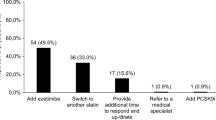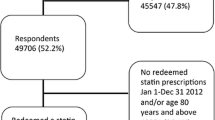Summary
Background: The objectives of this study are to describe levels of adherence to cholesterol-lowering medication and to identify predictors of adherence in patients with familial hypercholesterolaemia (FH).
Design: Descriptive questionnaire study.
Methods:: 336 adults patients with FH attending one of five outpatient lipid clinics in South East England underwent a clinical assessment by a nurse and completed a questionnaire. The questionnaire assessed self-reported adherence to cholesterol-lowering medication, anxiety, depression, and patient perceptions of heart disease.
Results:: Overall, participants reported high levels of medication adherence, although 63% reported some level of non-adherence. Total medication adherence (never deviating from the regimen) was more likely to be reported by older participants, those with no formal educational qualifications, those with a personal history of cardiovascular disease, those with a lower total cholesterol level, and those with a greater difference between untreated cholesterol levels and current cholesterol levels. The illness perceptions associated with reported total adherence were lower perceived risk of raised cholesterol, perceiving greater control over FH, and perceiving genes and cholesterol to be important determinants of a heart attack. Emotional state was not associated with medication adherence. In logistic regression analysis, predictors of total medication adherence were having personal history of cardiovascular disease, having no formal qualifications, and perceiving genes to be important determinants of a heart attack.
Conclusions: Both clinical factors and patients’ illness perceptions were associated with self-reported cholesterol-lowering medication adherence. The association with illness perceptions was small and many of these associations may be a consequence, rather than a cause, of greater adherence. Given this, intervention strategies aimed at helping patients’ to establish routines for medication taking may be more effective in increasing adherence than interventions designed to alter perceptions related to taking statins.
Similar content being viewed by others
References
Shepherd J, Cobbe SM, Ford I, et al. Prevention of coronary heart disease with pravastatin in men with hypercholesterolaemia. NEJM 1995;333:1301–1307.
Scandinavian Simvastatin Survival Study Group. Randomised trial of cholesterol lowering in 4444 patients with coronary heart disease: The Scandinavian Simvastatin Survival Study (4s). Lancet 1994;344:1383–1389.
Insull W. The problem of compliance to cholesterol altering therapy. J Intern Med 1997;241:317–325.
Umans-Eckenhausen MAW, Defesche JC, van Dam MJ, Kastelelein JJP. Long-term compliance with lipid-lowering medication after genetic screening for familial hypercholesterolemia. Arch Int Med 2003;163:65–68.
Myers LB, Midence K, eds. Adherence to Treatment in Medical Conditions. London: Harwood Academic Publishers, 1998.
Erikson M, Hadell K, Holme I, et al. Compliance with and efficacy of treatment with pravastatin and cholestyramine: A randomised study of lipid-lowering in primary care. J Intern Med 1998;243:373–380.
Avorn J, Monette J, Lacour A, et al. Persistence of use of lipid-lowering medications: A cross-national study. JAMA 279:1458–1462.
Petrie KJ, Weinman JA, eds. Perceptions of Health and Illness: Current Research and Applications. London: Harwood Academic Publishers, 1997.
Meyer D, Leventhal H, Gutmann M. Common-sense models of illness: The example of hypertension. Health Psychol 1995;4:115–135.
Horne R, Weinman J. Patients‘ beliefs about prescribed medicines and their role in adherence to treatment in chronic physical illness. J Psychosom Res 1999;47:555–567.
Kiortsis DN, Giral P, Bruckert E, et al. Factors associated with low compliance with lipid-lowering drugs in hyperlipidemic patients. J Clin Pharm Ther 2000;25:445– 451.
Simon Broome Steering Committee. Risk of fatal coronary disease in familial hypercholesterolaemia. Scientific Steering Committee on behalf of the Simon Broome Register Group. BMJ 1991;303:893–896.
Marteau TM, Senior V, Humphries SE, et al. Psychological impact of genetic testing for Familial Hypercholesterolemia with a previously aware population: A randomized controlled trial. AJMG 2004:128:285–293.
Rose GA, Blackburn H, Gillum RF, et al. Cardiovascular Survey Methods, 2nd ed. Geneva: World Health Organisation, 1982.
Moss Morris R, Weinman J, Petrie KJ, et al. The Revised Illness Perception Questionnaire (IPQ-R). Psychology and Health 2002;17:1–16.
Marteau TM, Bekker H. The development of a six-item short-form of the state scale of the Spielberger State-Trait Anxiety Inventory (STAI). Br J Clin Psychol 1992;31:301–306.
Zigmond AS, Snaith RP. The hospital anxiety and depression scale. Acta Psychiatrica Scandinavica 1983:67;361– 370.
Rudd P. The measurement of compliance: medication taking. In: Krasnegor NA, Epstein LH, Johnson SB, et al, eds. Developmental Aspects of Health Compliance Behavior. Hillsdale, New Jersey: Lawrence Erlbaum 1993:185– 213.
DiMatteo MR, Lepper HS, Croghan TW. Depression is a risk factor for noncompliance with medical treatment: Meta-analysis of the effects of anxiety and depression on patient adherence. Arch Intern Med 2000;160:2101–2107.
Sheeran P. Intention-behaviour relations: A conceptual and empirical review. In Hewstone M, Stroebe W, eds. European Review of Social Psychology (in press);11.
Sheeran P, Orbell S. Implementation intentions and repeated behaviour: Augmenting the predictive validity of the theory of planned behaviour. European Journal of Social Psychology 1999;29:349–369.
Author information
Authors and Affiliations
Consortia
Corresponding author
Additional information
This research was funded as part of a programme grant from The Wellcome Trust (ref: 037006)
Rights and permissions
About this article
Cite this article
Senior, V., Marteau, T.M., Weinman, J. et al. Self-Reported Adherence to Cholesterol-Lowering Medication in Patients with Familial Hypercholesterolaemia: The Role of Illness Perceptions. Cardiovasc Drugs Ther 18, 475–481 (2004). https://doi.org/10.1007/s10557-004-6225-z
Issue Date:
DOI: https://doi.org/10.1007/s10557-004-6225-z




